By David Crowe
A national nursing shortage is wrecking plans to improve aged care despite a looming federal bid to fix the troubled sector, with the deficit likely to double by 2030 as demand for nurses continues to rise.
Aged-care managers are warning of a “knife fight for staff” to ensure they can meet a federal edict to guarantee 40 minutes of clinical care for every resident each day, in a major flashpoint for a reform plan due within weeks.

A shortage of nurses comes despite the government expecting providers to boost the care delivered by a registered nurse to 44 minutes per resident per day from October.
Labor is seeking Coalition support for new rules to spur more investment in residential aged care by asking older Australians with more assets to pay more for daily services, as providers warn they will close beds without reform.
But the peak nursing federation is calling on aged-care providers to do more to meet the federal government mandate for daily care, and says the industry has to lift its standards to attract and retain nurses.
While the government expects providers to increase the care delivered by a registered nurse to 44 minutes a day per resident from October, it also forecasts a shortage of nurses this year and every year until at least 2035 because demand will outstrip supply.
The official figures show 50,232 nurses are in aged care this year, but the government forecasts demand for 55,572 nurses, which means there would be a shortage of 5340 nurses.
That shortage is forecast to grow to 9288 full-time nurses next year and reach 13,342 by 2030 without more action to train more nurses, bring in skilled foreign workers or retain more of those who leave aged care every year.
“It’s been a chronic shortage – it just can’t be denied, and we need to keep addressing it,” Australian Nursing and Midwifery Federation secretary Annie Butler said.
Butler said the aged-care package should include a mechanism to ensure the care targets were reached. But she countered claims from providers that they could not reach the targets because they could not find enough nurses.
“Unless there’s a consequence for not meeting those standards, it’s not going to happen,” she said.
Butler said her response was to ask providers why they did not offer nurses higher salaries to match those paid in hospitals, or offer more incentives to hire and retain them.
The federation, which estimates that 40 per cent of nurses were born overseas and 20 per cent were educated overseas, is in favour of streamlining the process to bring in more workers and says Australia needs more investment in local training.
The shortage has forced some aged-care providers to search for nurses from nearby employers while also losing existing staff to hospitals, with every new hire creating a gap somewhere else.
“There’s a knife fight for staff in the regions, with aged care and hospitals scrapping for the same staff,” said Duncan McKimm, the chief executive of Clarence Village in Grafton, in northern NSW.
“The combination of staff constraints and care minute targets make building new aged-care facilities largely unfeasible.
“The government knows there aren’t enough registered nurses to meet the targets. We need to design and fund an aged-care system based on the forecasts rather than pretend thousands of registered nurses and carers are going to materialise.”
Labor promised to improve aged care when it took power at the last election, saying it would act on the royal commission that exposed the neglect of older Australians, and has mandated 24/7 onsite clinical care as well as the minimum amount of nursing care that residents should receive each day.
Without enough staff to meet the mandate, some providers have dropped plans to add more beds despite the demand from older Australians who need to move from home or retirement villages into aged care.

Australian Nursing and Midwifery Federation secretary Annie Butler at a jobs and skills summit at Parliament House in 2022.Credit: James Brickwood
A government aged-care taskforce warned last year that the sector needed more staff and investment to support older Australians, but Labor and the Coalition are yet to reach a deal in parliament on the reforms.
Taskforce member Grant Corderoy, of accounting firm StewartBrown, has estimated providers will close 21,200 beds in net terms over the six years to 2030 unless changes are made to attract investment.
“Workforce reforms are critical and should be addressed by a separate reform agenda, not tied to the taskforce funding reforms,” Corderoy said.
Aged and Community Care Providers Association chief executive Tom Symondson said only about 40 per cent of all residential providers were currently meeting targets.
“While we’ve seen some improvement over the last year from the absolute worst point, we’ve only seen that because we haven’t been able to find enough workforce to deliver on the minutes targets,” he said.
“If 100 per cent [of providers] were meeting the targets, those losses would skyrocket.”
Federal authorities are likely to take the nurse shortage into account when looking at whether providers have met the mandate on daily care minutes, as long as there is no risk to residents and the providers are doing what they can to meet the targets.
Federal Aged Care Minister Anika Wells said the government had put $11.3 billion towards a wage rise for aged-care workers and was tackling the labour shortages as a major issue.
“This significantly improved pay for 250,000 workers and was the biggest pay rise for the sector, ever,” Wells said.
This year’s federal budget included $88.4 million over three years to develop the aged-care workforce, while state governments are also offering incentives to nurses, such as waiving their university fees.
UnitingCare national director Claerwen Little welcomed the federal pledge on aged-care wages but said the federal government needed a long-term workforce plan.

Aged Care Minister Anika Wells.Credit: James Brickwood
“We are acutely aware of chronic workforce shortages, particularly in regional and remote services,” she said.
“Our services are often forced to engage contract staff through recruitment agencies at an exorbitant cost to fill critical workforce shortages.”
While the nursing federation backs the federal mandate on daily care minutes, Catholic Health Australia said it was a factor in the pressure to find staff.
Catholic Health Australia director of aged-care policy Laura Haylen estimated the nurse shortage was far greater than some of the official figures showed, saying the sector had 60,000 care and nursing vacancies.
“The introduction of care minutes has required a significant uplift of staff,” Haylen said.
“While we welcome the government’s decisions to fund a wage increase and begin to recognise the importance of enrolled nurses by letting their minutes count towards the requirements, more needs to be done to address the workforce crisis.
“The government should subsidise nurses’ rents, help build more affordable housing for workers and restore [independent statutory body] Health Workforce Australia.”
Cut through the noise of federal politics with news, views and expert analysis. Subscribers can sign up to our weekly Inside Politics newsletter.